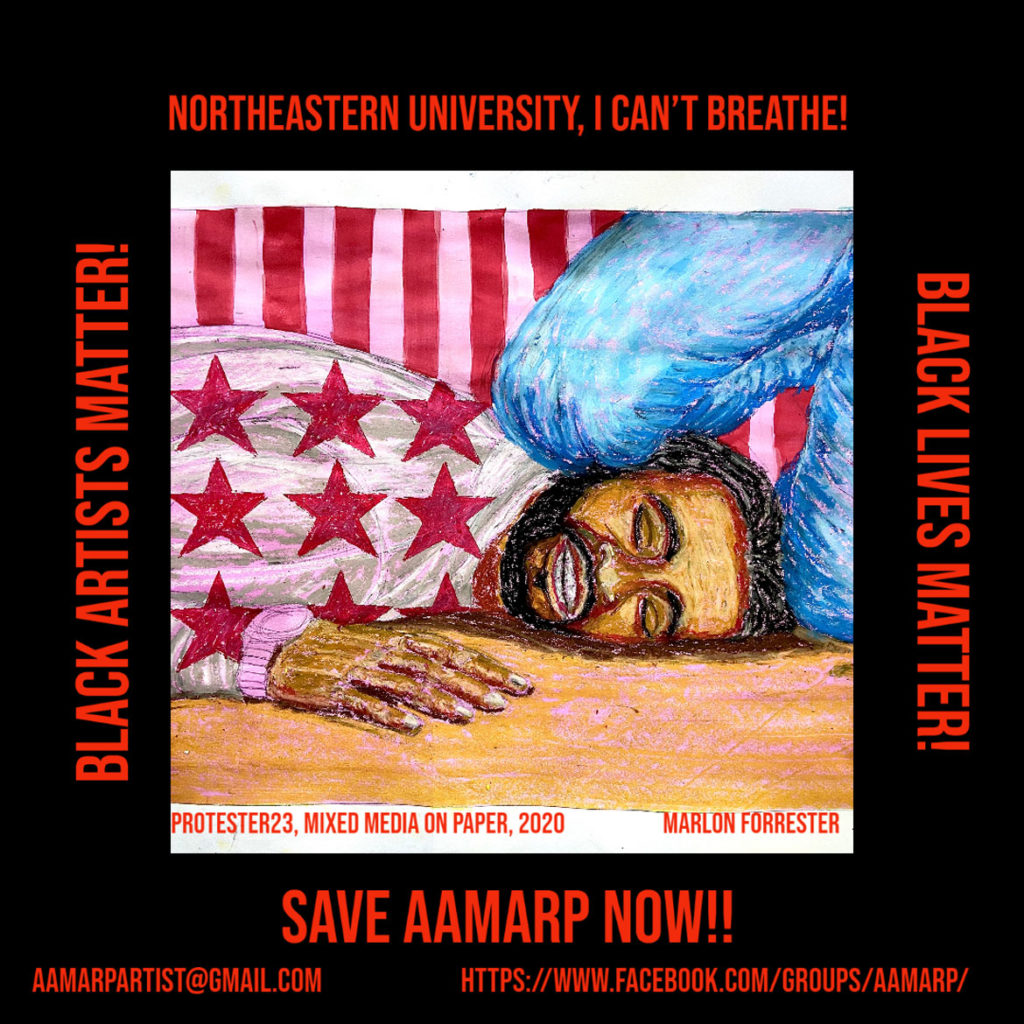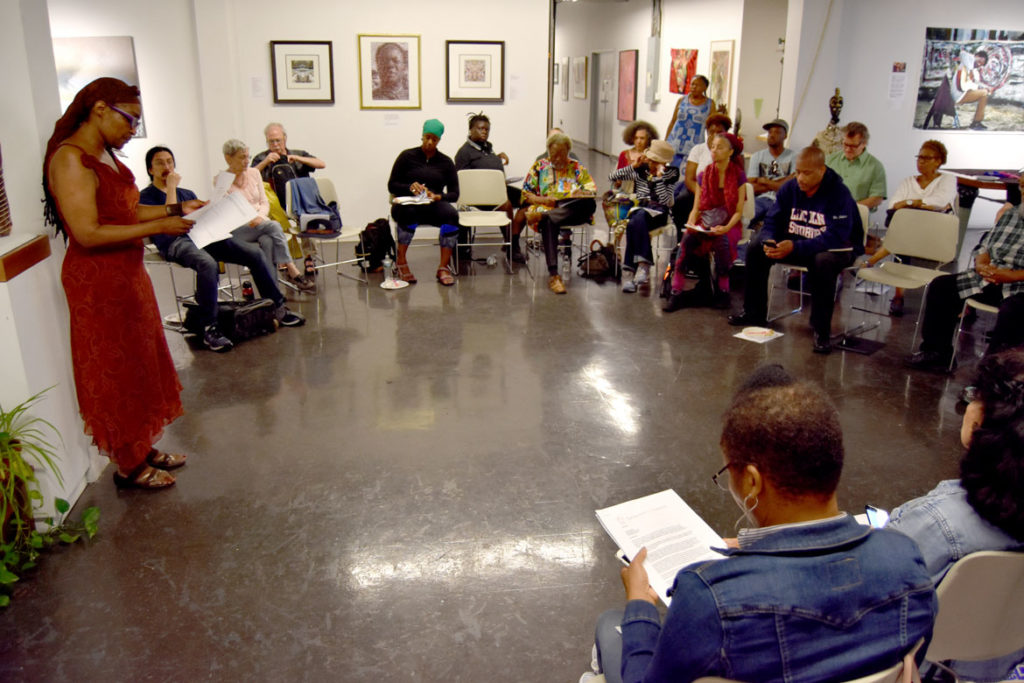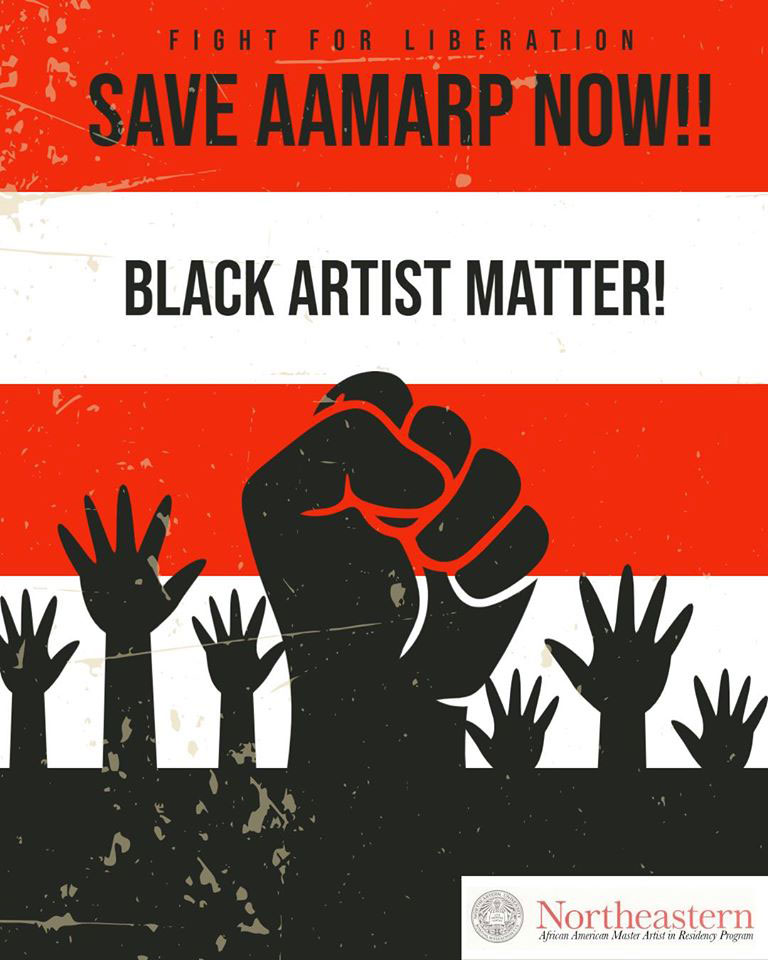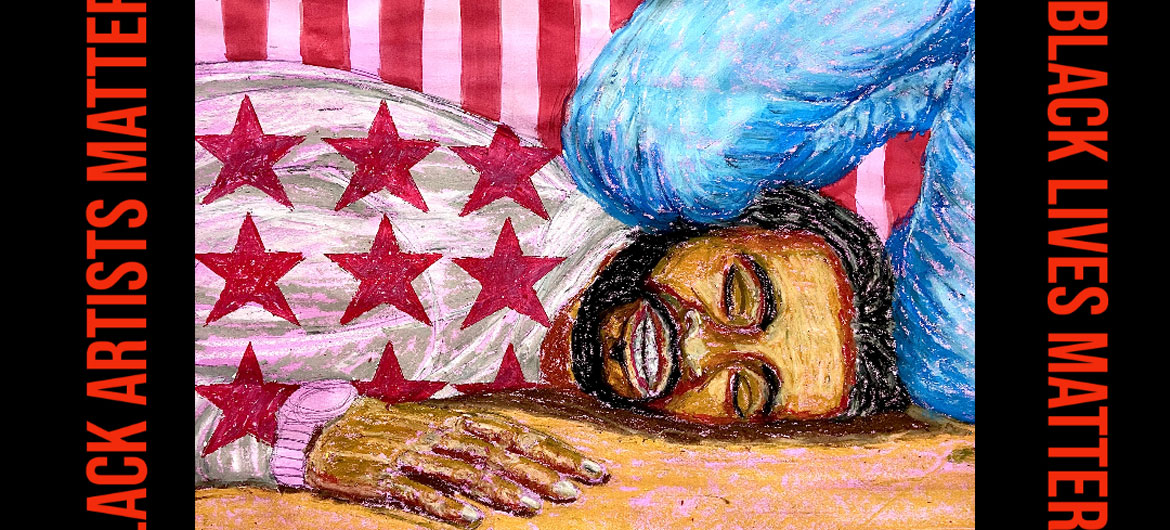Artists involved in the African American Master Artists In Residence Program at Northeastern University say that the Boston school has again locked artists out of the building the four-decade-old program for Black artists has long occupied in Jamaica Plain, and is trying to push the artists out of the facility.
“After two years of negotiations with Northeastern University Administration, African American Master Artists in Residence Program (AAMARP) artists are once again locked out of their studios at 76 Atherton Street, Jamaica Plain, Massachusetts. This lock out denies artists who critically need access to their art supplies, materials, tools and artworks, much on which their livelihood depends,” the group said in a press release sent out today.
The artists have scheduled a protest in front of the studio building for tomorrow, Saturday, June 27, at 2 p.m. “to demand that NEU let the artist back into their studios.”

Marlon Forrester, one of the 14 artists of the residency program, says they hope the protest will “bring light to this issue, which is Northeastern’s treatment of AAMARP—it’s been a 42 year relationship—and its ability to really understand that Black Lives Matter, specifically Black Artists Matter.”
“Northeastern at the beginning of the pandemic had closed off campus per the quarantine order,” Shea Justice, one of the resident artists, said via email. About two months ago, “some of the artists had to get materials from their studios and discovered the locks to the building had been changed with no communication from the school of their intentions.”
Renata Nyul, Northeastern’s vice president for communications, says via email, “Due to Covid-19, the facility is closed. There should be a sign on the door with information about how to get temporary access.”
“That response is, I think, an indication that they’ve put in place what they want for their narrative,” Forrester says. “This is what they can use now to create an alternative narrative using Covid.”
“If you’re not a Northeastern student or don’t have a Northeastern ID, which we don’t have, you can’t access” the school’s online portal to get building access, Forrester says. He says that Northeastern continues to allow other uses of the building including a print production facility and university storage.
“We did write a letter to [Northeastern] President [Joseph] Aoun and he did not respond,” says L’Merchie Frazier, another of the program’s resident artists.

Update June 27: Ralph Martin, general counsel at Northeastern, emails this message: “We do not understand the purpose of today’s protest. Due to the Covid-19 pandemic, and in compliance with public health guidelines, Northeastern University closed its Boston campus on March 17. All university buildings—including the warehouse at 76 Atherton Street—were closed and access was made available only upon special request.
“It is important to note that the artists associated with AAMARP do not pay rent to Northeastern and have never paid rent, despite occupying space in Northeastern buildings for more than 30 years. The university has been working with AAMARP leaders on a mutually agreeable plan to relocate the artists this fall, at significant cost to the university. Because the pandemic effectively put these discussions on hold for a period of time, the university will extend its plans to relocate the artists until the end of the 2020 calendar year.
“We are grateful to the artists—and all in the Northeastern community—for adhering to public health guidance and moving to remote work during the pandemic. By doing so, they have helped combat the effects of Covid-19, and enhanced the safety and well-being of the entire community.“
This new standoff between Northeastern and the resident artists echoes a dispute two years ago. On June 28, 2018, Maria Cimilluca, a Northeastern vice president for facilities, sent a letter to artists in the program ordering them to move out of program studios at 76 Atherton St. by that July 13 “because of hazardous conditions” in the building. Artists said the school changed the locks and didn’t issue them new keys. At the time, Northeastern spokesperson Renata Nyul wrote, “access to the artist space has never been revoked.”
“For at least five to 10 years, there’s been this harassment by Northeastern, this police presence by Northeastern,” Frazier says.
Under pressure from Boston Mayor Marty Walsh, Northeastern University repeatedly pushed back the deadline for when it said the artist residency prorgram must vacate a school building.
Northeastern then insisted that artists from the program keep quiet about the negotiations as they continued. Over the past year the residency program looked into moving to a Masonic building in Boston’s Uphams Corner, but the deal didn’t come to fruition.

The African American Master Artists In Residence Program was launched by artist, teacher and activist Dana Chandler in 1978 in a building Northeastern owned in Boston’s Roxbury neighborhood. It was a landmark project in its recognition of Black artists, in the amount of space offered, in the length of the residencies (three years to start, but many allowed to stay much longer; some current resident artists have been there decades), and it was “rent-free.” “Thus enabling the artists to produce works at a level of intensity none has ever been able to attain,” organizers wrote in the late 1970s.
Chandler served as the director until the 1990s. Amid budget cuts, “in 1991, they pushed my amount of time to work as director to one day a week and in 1993 they fired me,” Chandler told me previously. He said he maintained a studio there until 2004, when he relocated from Boston to New Mexico. Over the years, the program moved from Leon Street to a Huntington Avenue building, then back to Leon Street, and in recent years at 76 Atherton St.
“They want to use that building for something else,” Frazier says. “They have plans for that building.”
Forrester says, “They’ve decided that maybe this is the best way to have AAMARP residents out of the building and use this as a way of forced transition or eviction.”
The resident artists say the lockout has hurt their ability to make art and to apply for grants. “We have to work in order for us to eat,” Gloretta Baynes, director of the artists residency program, said in the press release. “This is absolutely ridiculous. Black Artists Matter. They must open these doors now.”
Previously
July 3, 2018: Northeastern Says Landmark Black Artists Residency Program ‘Must Vacate’ Jamaica Plain Building
July 25, 2018: Mayor Pushes Northeastern To Give Landmark Black Artists Residency Program More Time To Vacate Boston Building
Aug. 13, 2018: Northeastern Delays Deadline For Landmark Black Arts Program To Vacate Boston Building, Some Artists Object To Negotiation Ground Rules
Oct. 31, 2018: Black Arts Residency Program Continues Negotiations With Northeastern As Deadline To Get Out Passes

If this is the kind of coverage of arts, cultures and activisms you appreciate, please support Wonderland by contributing to Wonderland on Patreon. And sign up for our free, weekly newsletter so that you don’t miss any of our reporting.
All content © copyright by Greg Cook or its original creators.
